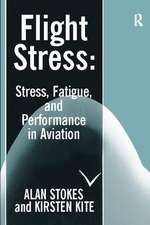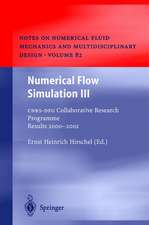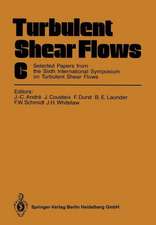Three-Dimensional Attached Viscous Flow: Basic Principles and Theoretical Foundations
Autor Ernst Heinrich Hirschel, Jean Cousteix, Wilhelm Kordullaen Limba Engleză Paperback – 23 aug 2016
This book provides basic principles and theoretical foundations regarding three-dimensional attached viscous flow. Emphasis is put on general three-dimensional attached viscous flows and not on three-dimensional boundary layers. This wider scope is necessary in view of the theoretical and practical problems to be mastered in practice.
The topics are weak, strong, and global interaction, the locality principle, properties of three-dimensional viscous flow, thermal surface effects, characteristic properties, wall compatibility conditions, connections between inviscid and viscous flow, flow topology, quasi-one- and two-dimensional flows, laminar-turbulent transition and turbulence.
Though the primary flight speed range is that of civil air transport vehicles, flows past other flying vehicles up to hypersonic speeds are also considered. Emphasis is put on general three-dimensional attached viscous flows and not on three-dimensional boundary layers, as this wider scope is necessary in view of the theoretical and practical problems that have to be overcome in practice.
The specific topics covered include weak, strong, and global interaction; the locality principle; properties of three-dimensional viscous flows; thermal surface effects; characteristic properties; wall compatibility conditions; connections between inviscid and viscous flows; flow topology; quasi-one- and two-dimensional flows; laminar-turbulent transition; and turbulence. Detailed discussions of examples illustrate these topics and the relevant phenomena encountered in three-dimensional viscous flows. The full governing equations, reference-temperature relations for qualitative considerations and estimations of flow properties, and coordinates for fuselages and wings are also provided. Sample problems with solutions allow readers to test their understanding.
| Toate formatele și edițiile | Preț | Express |
|---|---|---|
| Paperback (1) | 645.79 lei 6-8 săpt. | |
| Springer Berlin, Heidelberg – 23 aug 2016 | 645.79 lei 6-8 săpt. | |
| Hardback (1) | 582.81 lei 17-23 zile | +51.20 lei 7-13 zile |
| Springer Berlin, Heidelberg – 14 noi 2013 | 582.81 lei 17-23 zile | +51.20 lei 7-13 zile |
Preț: 645.79 lei
Preț vechi: 759.76 lei
-15% Nou
Puncte Express: 969
Preț estimativ în valută:
123.57€ • 129.36$ • 102.25£
123.57€ • 129.36$ • 102.25£
Carte tipărită la comandă
Livrare economică 05-19 aprilie
Preluare comenzi: 021 569.72.76
Specificații
ISBN-13: 9783662517482
ISBN-10: 3662517485
Pagini: 405
Ilustrații: XIV, 391 p. 134 illus., 19 illus. in color.
Dimensiuni: 155 x 235 x 21 mm
Greutate: 0.57 kg
Ediția:Softcover reprint of the original 1st ed. 2014
Editura: Springer Berlin, Heidelberg
Colecția Springer
Locul publicării:Berlin, Heidelberg, Germany
ISBN-10: 3662517485
Pagini: 405
Ilustrații: XIV, 391 p. 134 illus., 19 illus. in color.
Dimensiuni: 155 x 235 x 21 mm
Greutate: 0.57 kg
Ediția:Softcover reprint of the original 1st ed. 2014
Editura: Springer Berlin, Heidelberg
Colecția Springer
Locul publicării:Berlin, Heidelberg, Germany
Cuprins
Introduction.- Properties of Three-Dimensional Attached Viscous Flow.- Equations of Motion.- Boundary-Layer Equations for Three-Dimensional Flow.- Boundary-Layer Integral Parameters.- Viscous Flow and Inviscid Flow Connections and Interactions.- Topology of Skin-Friction Fields.- Quasi-One-Dimensional and Quasi-Two-Dimensional Flows.- Laminar-Turbulent Transition and Turbulence.- Illustrating Examples.- Solutions of the Problems.
Recenzii
“The book would be an appropriate resource for every student of aerodynamics. … The book is well structured, and the bibliography which partially follows the chapters and sections is comprehensive. In order to test the reader’s understanding of the material, each chapter is accompanied by various problems and their solutions. A lot of graphics, including colored pictures, illustrate the book very well.” (Jürgen Socolowsky, Mathematical Reviews, April, 2017)
Textul de pe ultima copertă
Viscous flow is usually treated in the frame of boundary-layer theory and as a two-dimensional flow. At best, books on boundary layers provide the describing equations for three-dimensional boundary layers, and solutions only for certain special cases.
This book presents the basic principles and theoretical foundations of three-dimensional attached viscous flows as they apply to aircraft of all kinds. Though the primary flight speed range is that of civil air transport vehicles, flows past other flying vehicles up to hypersonic speeds are also considered. Emphasis is put on general three-dimensional attached viscous flows and not on three-dimensional boundary layers, as this wider scope is necessary in view of the theoretical and practical problems that have to be overcome in practice.
The specific topics covered include weak, strong, and global interaction; the locality principle; properties of three-dimensional viscous flows; thermal surface effects; characteristic properties; wall compatibility conditions; connections between inviscid and viscous flows; flow topology; quasi-one- and two-dimensional flows; laminar-turbulent transition; and turbulence. Detailed discussions of examples illustrate these topics and the relevant phenomena encountered in three-dimensional viscous flows. The full governing equations, reference-temperature relations for qualitative considerations and estimations of flow properties, and coordinates for fuselages and wings are also provided. Sample problems with solutions allow readers to test their understanding.
This book presents the basic principles and theoretical foundations of three-dimensional attached viscous flows as they apply to aircraft of all kinds. Though the primary flight speed range is that of civil air transport vehicles, flows past other flying vehicles up to hypersonic speeds are also considered. Emphasis is put on general three-dimensional attached viscous flows and not on three-dimensional boundary layers, as this wider scope is necessary in view of the theoretical and practical problems that have to be overcome in practice.
The specific topics covered include weak, strong, and global interaction; the locality principle; properties of three-dimensional viscous flows; thermal surface effects; characteristic properties; wall compatibility conditions; connections between inviscid and viscous flows; flow topology; quasi-one- and two-dimensional flows; laminar-turbulent transition; and turbulence. Detailed discussions of examples illustrate these topics and the relevant phenomena encountered in three-dimensional viscous flows. The full governing equations, reference-temperature relations for qualitative considerations and estimations of flow properties, and coordinates for fuselages and wings are also provided. Sample problems with solutions allow readers to test their understanding.
Caracteristici
Presents the basic principles and theoretical foundations of three-dimensional attached viscous flow Focuses on properties of three-dimensional viscous flow past realistic shapes of finite extension with a flight speed range from civil air transport vehicles up to hypersonic flight vehicles The authors are deeply involved in phenomenological, mathematical and computational issues of attached three-dimensional viscous flow - in teaching, research, and industrial application Gives researchers, student and, in particular, the practical aerospace engineer the needed knowledge about three-dimensional attached viscous flow Presents detailed examples in order to illustrate the treated concepts and phenomena found in attached three-dimensional viscous flows














